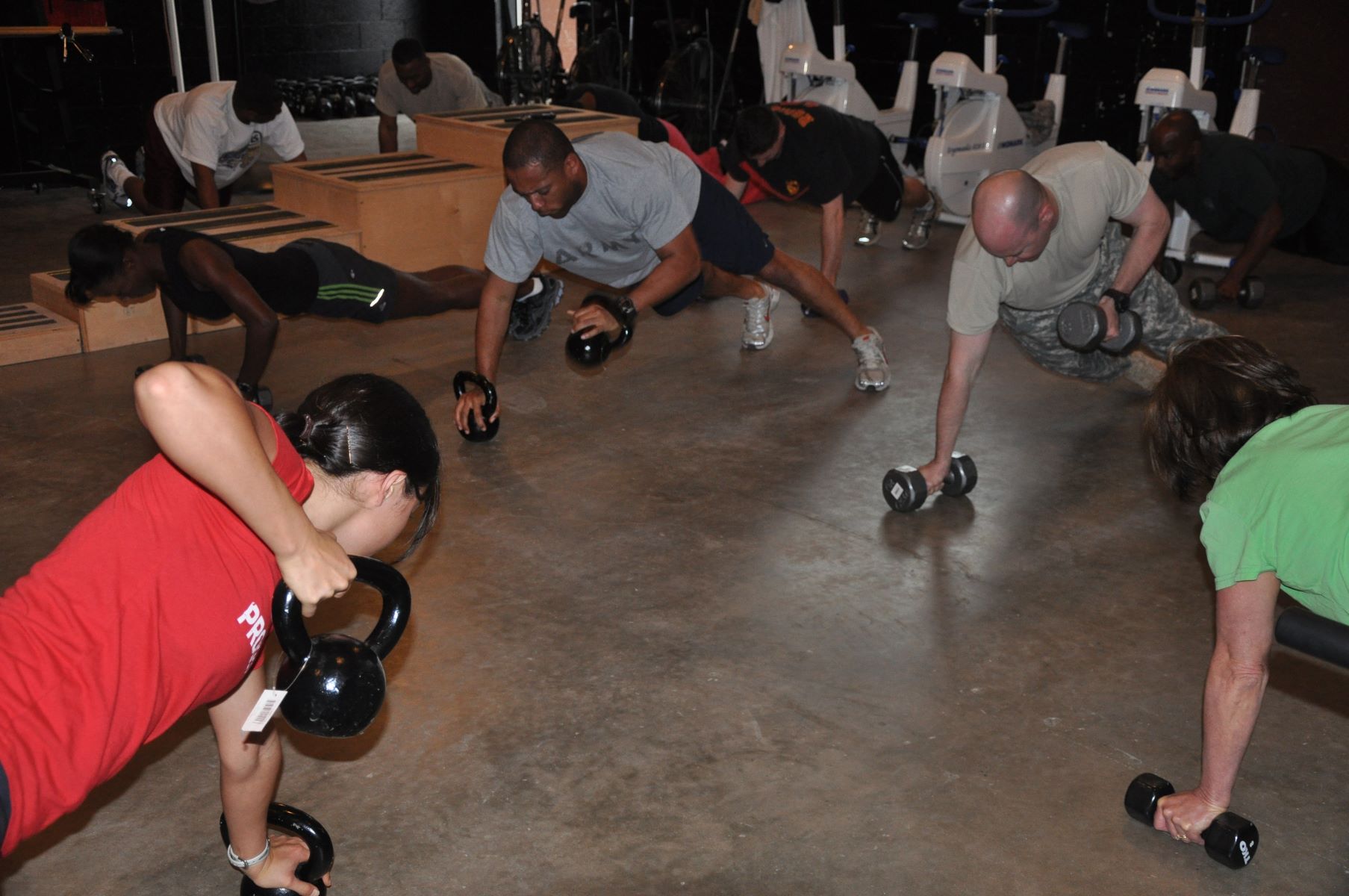Home>Misc>Featured>What Is The Best Plan To Improve Your Muscular Endurance?


Featured
What Is The Best Plan To Improve Your Muscular Endurance?
Modified: October 24, 2023
Discover the best plan to improve your muscular endurance with our featured program. Get stronger and more resilient through targeted workouts and expert guidance.
Introduction
Are you looking to improve your muscular endurance? Whether you’re an athlete, a fitness enthusiast, or someone simply looking to enhance their overall physical fitness, developing your muscular endurance can greatly benefit you. Muscular endurance refers to the ability of your muscles to perform repetitive contractions over an extended period of time.
Having good muscular endurance is crucial for activities that require a sustained effort, such as running, cycling, swimming, and even day-to-day tasks like carrying groceries or climbing stairs. By improving your muscular endurance, you can boost your stamina, reduce fatigue, enhance your overall performance, and even prevent injuries.
However, improving muscular endurance isn’t something that happens overnight. It requires a well-rounded training plan targeting specific muscle groups and incorporating the right exercises, intensity, repetitions, and rest intervals. In this article, we will delve into creating the best plan to improve your muscular endurance and help you achieve your fitness goals.
Before we dive into the details, it’s important to understand the factors that influence muscular endurance. These factors include genetics, muscle fiber type, cardiovascular fitness, and training history. While genetic factors play a role in determining your baseline muscular endurance, you can still make significant improvements through proper training and dedication.
In the following sections, we will guide you through the process of designing an effective muscular endurance training plan. This includes selecting the right exercises, determining the appropriate intensity and repetitions, structuring your training sessions, incorporating rest and recovery periods, and tracking your progress. By following these guidelines, you can optimize your training routine and maximize your muscular endurance gains.
Understanding Muscular Endurance
Muscular endurance is a key component of physical fitness, particularly in activities that require prolonged muscle contractions. It is the ability of your muscles to perform repeated contractions against resistance over an extended period of time. Unlike muscular strength, which focuses on the maximum force you can produce, muscular endurance is about sustaining muscle contractions over a prolonged period.
There are two types of muscular endurance: local muscular endurance and general muscular endurance. Local muscular endurance refers to the ability of specific muscles or muscle groups to sustain contractions, such as the endurance of your leg muscles during a long run. General muscular endurance, on the other hand, involves the overall endurance of your entire body, including your cardiovascular system.
Muscular endurance is influenced by various factors, including muscle fiber type, aerobic capacity, and muscular strength. Type I, or slow twitch, muscle fibers have a high endurance capacity and are responsible for sustained activities like long-distance running. Type II, or fast twitch, muscle fibers are better suited for explosive movements but have lower endurance capacity. However, it’s important to note that with proper training, you can improve the endurance of both types of muscle fibers.
Improving muscular endurance offers numerous benefits. First and foremost, it allows you to perform at a higher intensity level for longer durations during physical activities. This is particularly important in sports that involve repetitive movements or endurance-based events. By enhancing your muscular endurance, you can delay the onset of fatigue and maintain optimal performance.
Furthermore, increasing muscular endurance can lead to improved overall cardiovascular health. As your muscles become more efficient at utilizing oxygen, your heart and lungs also benefit from increased endurance. This can result in improved cardiovascular fitness, reduced risk of heart disease, and enhanced overall health and well-being.
Another advantage of developing muscular endurance is injury prevention. Muscular imbalances, inadequate muscular endurance, and fatigue can increase the risk of injuries during physical activities. By strengthening the muscles involved and improving their endurance, you can reduce the chances of muscle strains, sprains, and other related injuries.
Now that we have a solid understanding of muscular endurance and its benefits, let’s move on to designing a training plan that will help you improve your muscular endurance and achieve your fitness goals.
Benefits of Improving Muscular Endurance
Improving your muscular endurance offers a wide range of benefits that can positively impact your overall physical fitness and daily life. Let’s explore some of the key advantages of enhancing muscular endurance:
- Enhanced Stamina: Muscular endurance allows you to perform repetitive movements or activities for a longer period without experiencing fatigue. By improving your muscular endurance, you can increase your stamina and endurance in various physical activities, such as running, cycling, swimming, or even performing household chores.
- Reduced Fatigue: Fatigue can hinder your performance and make it difficult to accomplish physical tasks. By increasing your muscular endurance, you can delay the onset of fatigue, allowing you to maintain optimal performance for a longer duration. This can be particularly beneficial for athletes, as it can help them perform at their best during competitions and training sessions.
- Improved Athletic Performance: Muscular endurance is crucial in many sports and athletic activities. By developing your muscular endurance, you can enhance your performance in sports that require sustained effort, such as long-distance running, swimming, or cycling. It can also improve your ability to perform repetitive movements in sports like basketball, soccer, or tennis.
- Increased Metabolic Efficiency: Improving your muscular endurance can enhance your body’s metabolic efficiency. Muscles with higher endurance capacity are more efficient at utilizing energy, which can lead to increased calorie burn and improved overall metabolic rate. This can be beneficial for weight management and achieving fitness goals.
- Reduced Risk of Injuries: Muscular endurance training can help prevent injuries by strengthening the muscles involved in various activities and improving their endurance. With stronger and more resilient muscles, you are less likely to experience muscle strains, sprains, or other injuries during physical activities.
- Enhanced Overall Fitness: Improving your muscular endurance contributes to overall physical fitness. It helps you develop a balanced and strong musculoskeletal system, improves joint stability, and promotes better posture and body alignment. Additionally, it can have a positive impact on cardiovascular health, reducing the risk of heart disease and other cardiovascular conditions.
- Improved Quality of Life: When your muscles are conditioned and have good endurance, day-to-day activities become easier. Whether it’s carrying groceries, climbing stairs, or performing household chores, having improved muscular endurance allows you to perform these tasks with less effort and fatigue, leading to an improved quality of life.
As you can see, the benefits of improving muscular endurance extend beyond just physical performance. They positively impact various aspects of your life, promoting a healthier and more active lifestyle. So, let’s move on to the next section where we will discuss the factors that affect muscular endurance and how to take them into account when designing a training plan.
Factors Affecting Muscular Endurance
Several factors come into play when it comes to muscular endurance. Understanding these factors will help you tailor your training plan to optimize your results. Let’s take a closer look at the key aspects that influence muscular endurance:
- Genetics: Genetics plays a role in determining your baseline muscular endurance. Some individuals may naturally have a higher capacity for endurance due to genetic factors such as muscle fiber composition and aerobic capacity. However, keep in mind that genetics only provide a starting point, and with proper training, you can still make significant improvements regardless of your genetic predisposition.
- Muscle Fiber Type: Your muscle fiber composition affects your muscular endurance. There are two main types of muscle fibers: Type I (slow twitch) and Type II (fast twitch). Type I fibers have a high endurance capacity and are more resistant to fatigue, while Type II fibers are better suited for short bursts of intense activity but have lower endurance. However, through training, you can improve the endurance of both fiber types.
- Cardiovascular Fitness: Your cardiovascular fitness plays a crucial role in muscular endurance. Your heart and lungs deliver oxygen-rich blood to your muscles, providing the necessary fuel for sustained contractions. Improving your cardiovascular fitness through aerobic exercises like running, cycling, or swimming enhances your endurance capacity and supports better muscular endurance.
- Training History: Your past training experiences and history can impact your muscular endurance. If you have been consistently engaged in physical activities that require endurance, your muscles and cardiovascular system may already have a higher endurance capacity compared to someone who is just starting. However, with consistent training, even beginners can improve their muscular endurance.
- Nutrition and Hydration: Proper nutrition and hydration are crucial for optimizing muscular endurance. The fuel you provide to your body plays a significant role in muscle performance and endurance. Ensure you consume a balanced diet with adequate protein, carbohydrates, and healthy fats to fuel your workouts. Additionally, staying hydrated helps maintain muscle function and prevents fatigue during prolonged exercise.
Understanding these factors allows you to tailor your training plan to address any limitations and maximize your potential for improvement. Keep in mind that while some factors are beyond your control, such as genetics, you can still make significant progress by focusing on training, nutrition, and overall fitness level.
Now that we have covered the factors affecting muscular endurance, the next section will delve into designing a training plan that effectively targets and improves your muscular endurance. So let’s move forward to explore the key considerations when planning your workouts.
Designing a Muscular Endurance Training Plan
When designing a training plan to improve muscular endurance, it’s important to consider several key factors. By addressing these factors, you can create a well-rounded plan that targets specific muscle groups, incorporates the right exercises, intensity, repetitions, and rest intervals. Let’s explore these considerations in more detail:
- Choosing the Right Exercises: Select exercises that target the specific muscle groups you want to improve. Include both compound exercises that work multiple muscle groups simultaneously and isolation exercises that focus on individual muscles. This ensures that you are working all the relevant muscles and achieving balanced development.
- Determining the Right Intensity and Repetitions: The intensity of your training should be challenging enough to stimulate muscular endurance adaptations, but not so intense that you sacrifice proper form. Aim for a weight or resistance level that allows you to perform 12-20 repetitions per set. Gradually increase the resistance as you progress to continue challenging your muscles.
- Structuring Your Training Sessions: Divide your training into specific workout sessions targeting different muscle groups. For example, you can focus on upper body exercises one day and lower body exercises the next. This allows for adequate recovery time and prevents overtraining. Aim to train each muscle group two to three times per week.
- Incorporating Rest and Recovery: Rest and recovery are crucial for muscle growth and endurance improvement. Ensure that you incorporate rest days into your training plan to allow your muscles to recover and rebuild. Additionally, prioritize quality sleep, proper nutrition, and active recovery methods like stretching and foam rolling.
- Tracking and Evaluating Progress: Keep track of your workouts to monitor your progress. Record the exercises, weights, repetitions, and sets performed during each session. This allows you to progressively increase the workload over time and ensure that you are continually challenging your muscles.
Remember, consistency is key when it comes to improving muscular endurance. Aim to follow your training plan consistently and gradually increase the challenge to push your limits. However, listen to your body and adjust the intensity or volume if you experience excessive fatigue or discomfort.
In the next section, we will provide specific recommendations for exercises that are effective for improving muscular endurance. So let’s move on to explore the best exercises to incorporate into your training routine.
Choosing the Right Exercises
When designing a training plan to improve muscular endurance, selecting the right exercises is essential. Incorporating a variety of exercises that target different muscle groups ensures that you develop balanced muscular endurance throughout your body. Here are some guidelines to help you choose the right exercises:
- Compound Exercises: Include compound exercises that engage multiple muscle groups simultaneously. These exercises not only improve muscular endurance but also promote functional strength and coordination. Examples of compound exercises include squats, deadlifts, lunges, push-ups, pull-ups, and bench presses.
- Isolation Exercises: Supplement your compound exercises with isolation exercises that specifically target individual muscles or muscle groups. These exercises allow you to focus on particular areas and ensure you develop endurance in all the relevant muscles. Examples of isolation exercises include bicep curls, tricep dips, lateral raises, calf raises, and hamstring curls.
- Variation and Progression: Incorporate a variety of exercises to challenge your muscles in different ways. This prevents boredom and plateaus while providing a comprehensive workout for overall muscular endurance. Additionally, as you progress, increase the intensity, resistance, or difficulty of the exercises to continue challenging your muscles and promoting endurance improvements.
- Cardiovascular Exercises: Consider including cardiovascular exercises in your training plan to enhance your overall endurance. Activities such as running, cycling, swimming, and rowing engage large muscle groups and improve cardiovascular fitness, which in turn supports muscular endurance. Alternating between cardiovascular exercises and resistance training can provide a well-rounded approach to improving overall muscular endurance.
- Functional Movements: Incorporate exercises that mimic functional movements you perform in daily life or sports activities. This helps improve not only muscular endurance but also the efficiency and strength of movements in real-life scenarios. Functional exercises can include step-ups, lunges, kettlebell swings, medicine ball exercises, and agility drills.
Remember to prioritize proper form and technique during each exercise to avoid injury and maximize the benefits. If you are new to a particular exercise, start with lighter weights or resistance and gradually increase the intensity as your form improves and your muscular endurance progresses.
In the next section, we will discuss how to determine the appropriate intensity and repetitions for your muscular endurance training. So let’s move forward and explore these crucial aspects of your training plan.
Determining the Right Intensity and Repetitions
When it comes to improving muscular endurance, finding the right balance of intensity and repetitions is crucial. The intensity refers to the level of resistance or weight used, while the repetitions are the number of times you perform a specific exercise. Here are some guidelines to help you determine the appropriate intensity and repetitions for your muscular endurance training:
- Maintaining Proper Form: Focus on maintaining proper form throughout each exercise. It’s essential to perform the exercises with good technique, even as you fatigue. Sacrificing form for additional repetitions can compromise the effectiveness of the exercise and increase the risk of injury.
- Selecting a Moderate Weight: Choose a weight that allows you to perform 12-20 repetitions per set with good form. This weight should be challenging enough to stimulate your muscles but not so heavy that you cannot complete the desired number of repetitions. If you can easily perform more than 20 repetitions, consider increasing the weight to increase the intensity.
- Using Resistance Bands or Bodyweight: If you don’t have access to weights or prefer a more portable option, resistance bands or bodyweight exercises can be effective for improving muscular endurance. With resistance bands, choose a band that provides just enough resistance to challenge your muscles for the desired number of repetitions. For bodyweight exercises, focus on increasing the difficulty or intensity by modifying the exercise or adding variations.
- Progressive Overload: To continue making progress, gradually increase the intensity or resistance as your muscular endurance improves. This can be done by increasing the weight, using more resistance bands, or performing more challenging variations of bodyweight exercises. Progressive overload ensures that your muscles continue to adapt and grow stronger.
- Listening to Your Body: Pay attention to how your body feels during and after each exercise. If you experience excessive fatigue or discomfort, decrease the intensity or take a longer rest period. It’s important to find a balance between pushing your limits and allowing adequate recovery for optimal muscular endurance improvements.
Remember that the right intensity and repetitions will vary depending on your fitness level, training experience, and specific goals. It’s recommended to consult with a fitness professional or trainer to ensure you are targeting the appropriate intensity and repetitions for your individual needs.
In the next section, we will discuss how to structure your training sessions effectively to optimize muscular endurance gains. So let’s move forward and explore the key considerations when planning your workouts.
Structuring Your Training Sessions
Structuring your training sessions is vital to ensure that your muscular endurance training plan is effective and balanced. By dividing your training into specific workout sessions targeting different muscle groups, you can optimize your results and prevent overtraining. Here are some key considerations when structuring your training sessions:
- Splitting Muscle Groups: Divide your training sessions based on specific muscle groups or movement patterns. For example, you can focus on upper body exercises on one day and lower body exercises on another. This allows for adequate recovery time for each muscle group while ensuring that you target all major muscle groups throughout the week.
- Frequency: Train each muscle group two to three times per week to maximize muscular endurance improvements. Spacing out your sessions allows for adequate recovery while still providing enough stimulus to make progress. However, be mindful not to overtrain by giving each muscle group enough time to rest and recover between sessions.
- Variety: Incorporate variety in your training sessions to keep your workouts interesting and engaging. Use different exercises, equipment, and training modalities to target your muscles from different angles. This not only helps prevent boredom but also challenges your muscles in different ways, promoting overall muscular endurance development.
- Progressive Overload: Gradually increase the resistance or intensity of your exercises over time. This could mean adding more weight, using heavier resistance bands, or increasing the difficulty of bodyweight exercises through variations or progressions. Progressive overload ensures that your muscles continue to adapt and grow stronger, leading to improved muscular endurance.
- Warm-up and Cool-down: Always start your training sessions with a proper warm-up to prepare your muscles and joints for the upcoming exercises. Incorporate dynamic stretches and light cardio exercises to increase blood flow and loosen up your muscles. Similarly, end your workout with a cool-down period that includes static stretches to promote flexibility and aid in muscle recovery.
- Listen to Your Body: Pay attention to how your body feels during your training sessions. If you experience excessive fatigue, pain, or discomfort, make adjustments as needed. It’s essential to find a balance between pushing yourself to challenge your muscles and avoiding overexertion or injury.
Remember, the structure of your training sessions can be flexible based on your preferences and schedule. The most important aspect is ensuring that you allocate adequate time for each muscle group, provide progressive overload, and prioritize proper warm-up and cool-down routines for optimal results.
In the next section, we will discuss the importance of incorporating rest and recovery periods into your training plan. So let’s move forward and explore how rest and recovery play a crucial role in improving muscular endurance.
Incorporating Rest and Recovery
Rest and recovery are essential components of any successful training plan, including those aimed at improving muscular endurance. While consistent training is crucial, it’s equally important to give your muscles and body adequate time to rest and recover. Here are key points to consider when incorporating rest and recovery into your plan:
- Scheduled Rest Days: Plan regular rest days into your training schedule to allow your muscles and central nervous system to recover from the stress of training. These rest days give your body time to repair and rebuild, which is essential for improving muscular endurance. Listen to your body and take additional rest days if needed, especially if you experience excessive fatigue or soreness.
- Active Recovery: Incorporate active recovery activities on rest days to promote blood flow and aid in muscle recovery. Activities such as light stretching, yoga, swimming, or low-intensity cardio can help reduce muscle soreness and keep you active without putting additional stress on your muscles.
- Proper Nutrition: Fueling your body with the right nutrients is crucial for optimal recovery. Ensure you consume a well-balanced diet that includes sufficient protein, carbohydrates, and healthy fats. Protein is particularly important for muscle repair and growth. Hydration is also key, as it supports proper muscle function and aids in recovery.
- Quality Sleep: Sleep plays a vital role in recovery, as it is during sleep that your body repairs and rebuilds tissues. Aim for seven to nine hours of quality sleep each night to optimize the recovery process. Create a sleep routine that promotes relaxation and follow good sleep hygiene practices for better sleep quality.
- Foam Rolling and Stretching: Utilize foam rollers, massage tools, or stretching exercises to release tension in your muscles. Foam rolling, also known as self-myofascial release, can help improve muscle flexibility, reduce muscle soreness, and enhance muscle recovery. Stretching exercises can also aid in maintaining and improving flexibility while reducing the risk of injuries.
- Progressive Overload with Caution: While progressive overload is necessary for improvement, it’s important to gradually increase the intensity or workload without pushing beyond your limits. Overloading too quickly or excessively can lead to overtraining and increased risk of injury. Strive for a progressive approach that allows for steady gains while still providing ample recovery time.
Remember, rest and recovery are key components of the training process. Neglecting to incorporate adequate recovery periods can hinder muscular endurance gains, increase the risk of overuse injuries, and lead to burnout. Prioritize rest and recovery, listen to your body, and make adjustments to your training schedule or intensity as needed for optimal results.
In the next section, we will discuss the importance of tracking and evaluating your progress as you work towards improving muscular endurance. So let’s move forward and explore effective ways to measure your training results.
Tracking and Evaluating Progress
Tracking and evaluating your progress is crucial when working towards improving muscular endurance. Keeping tabs on your performance allows you to monitor your advancement, make necessary adjustments, and stay motivated. Here are some effective ways to track and evaluate your progress:
- Workout Journal: Maintain a workout journal to record your exercises, sets, repetitions, and weights for each training session. This provides a clear reference of your progress over time. You can also track your rest intervals, perceived exertion, and any notes about how your body feels during or after each workout.
- Performance Metrics: Use performance metrics to measure improvements in muscular endurance. For example, you can track the time it takes you to complete a specific exercise or workout, the number of repetitions you can perform with a given weight, or the total volume lifted (weight x repetitions x sets). Regularly reassess these metrics to celebrate progress and set new goals.
- Physical Measurements: Take regular physical measurements to observe changes in your body composition. While muscular endurance training may not necessarily result in significant muscle bulk, you may notice changes in muscle tone and definition. You can measure body weight, body fat percentage, or use measurement tools like calipers to track changes in specific areas of the body.
- Timed Challenges: Time yourself during specific exercises or workouts to determine your level of improvement. For example, you might time how long it takes you to complete a certain number of repetitions of an exercise or how long you can sustain a particular exercise without resting. By comparing these times over time, you can gauge improvements in muscular endurance.
- Progress Photos: Take progress photos at regular intervals to visually assess any changes in your physique. While muscular endurance improvements might not be as visually dramatic as strength or hypertrophy training, progress photos can still provide a tangible way to see how your body composition is evolving and reinforce your dedication to your training.
- Subjective Feedback: Pay attention to how you feel during training and throughout the day. Notice changes in your energy levels, endurance, and overall fitness capacity. Subjective feedback is an important measure of progress and can help you gauge your overall well-being and how your body is responding to your training efforts.
Regularly review and analyze the data and observations from your tracking methods. Use this information to identify trends, make adjustments to your training plan, and set realistic goals. Celebrate your progress, no matter how small, and use it as motivation to continue pushing forward.
In the next section, we will discuss modified training plans for specific goals, allowing you to tailor your approach based on individual needs. So let’s move forward and explore how different goals can influence your muscular endurance training plan.
Modified Training Plans for Specific Goals
When it comes to improving muscular endurance, the specific goals you have in mind can influence how you design and modify your training plan. Whether you’re an athlete training for a specific sport, aiming to increase your endurance for a particular activity, or simply looking to improve your overall fitness, tailoring your approach to your goals can lead to better results. Here are some modified training plans for specific goals:
- Athletic Performance: If you’re an athlete looking to enhance your performance in sports that require sustained effort, such as running, cycling, or swimming, your training plan should prioritize movements that mimic the demands of your specific sport. Incorporate exercises that involve repetitive movements and engage the relevant muscle groups. Additionally, incorporate interval training sessions to simulate the intensity and recovery cycles you’ll experience during competition.
- Endurance Activities: If your goal is to improve endurance for specific activities like long-distance running, cycling, or hiking, your training plan should focus on building the endurance capacity of the relevant muscle groups. Progressive long-distance training sessions, tempo runs, hill repeats, and cycling intervals can be effective strategies for improving endurance in these specific activities. Consider gradually increasing the duration or intensity of your workouts to build your endurance over time.
- General Fitness: If your goal is to improve your overall fitness and stamina, incorporate a well-rounded training plan that targets all major muscle groups. This can include a mix of compound and isolation exercises to promote balanced muscular endurance. Consider circuit training or high-intensity interval training (HIIT) sessions to improve cardiovascular fitness while challenging your muscles. Remember to include rest days and adequate recovery periods to avoid overtraining.
- Weight Loss: If weight loss is your primary goal, focus on a combination of resistance training and cardiovascular exercises. Resistance training helps preserve muscle mass while promoting fat loss, and cardiovascular exercises increase calorie burn. Incorporate high-repetition, low-resistance exercises to promote muscular endurance while engaging in regular aerobic activities like jogging, cycling, or swimming to burn calories and improve cardiovascular fitness.
- Injury Prevention: If your goal is to prevent injuries by improving muscular imbalances and overall muscle endurance, focus on exercises that target weaker muscle groups and promote balance throughout your body. Incorporate unilateral exercises (exercises that work one side of the body at a time) to address any imbalances. Emphasize core strength and stability exercises to provide a solid foundation for proper movement patterns and reduce the risk of injuries.
Remember, these modified training plans are just examples, and it’s important to customize your training plan based on your specific goals, fitness level, and preferences. Consult with a fitness professional or trainer to help you design a plan that is tailored to your needs and abilities.
In the next section, we will summarize the key points discussed throughout this article and provide a final perspective on improving muscular endurance. So let’s wrap up our journey towards improving muscular endurance.
Conclusion
Improving your muscular endurance is a journey that requires dedication, proper planning, and consistency. By understanding the principles of muscular endurance, considering the factors that influence it, and designing a comprehensive training plan, you can make significant progress in enhancing your muscular endurance.
Throughout this article, we have explored the benefits of improving muscular endurance, the factors that affect it, and the key considerations for designing an effective training plan. We discussed the importance of choosing the right exercises, determining the appropriate intensity and repetitions, and structuring your training sessions to optimize your results.
We also emphasized the significance of incorporating adequate rest and recovery into your training plan, as well as tracking and evaluating your progress to stay motivated and make necessary adjustments. We highlighted the importance of customized training plans for specific goals, allowing you to tailor your approach based on individual needs.
Remember, improving muscular endurance takes time and patience. It is crucial to listen to your body, make adjustments as needed, and celebrate your progress along the way. Each small step forward brings you closer to your ultimate goal of better endurance, performance, and overall fitness.
As you embark on your journey to improve muscular endurance, stay focused, stay committed, and always prioritize your safety and well-being. Consult with a fitness professional or trainer if needed, and enjoy the process of pushing your limits and surpassing your goals.
Now, armed with the knowledge and guidance provided in this article, it’s time to take action and embark on your journey towards improved muscular endurance. Best of luck on your fitness endeavors!









